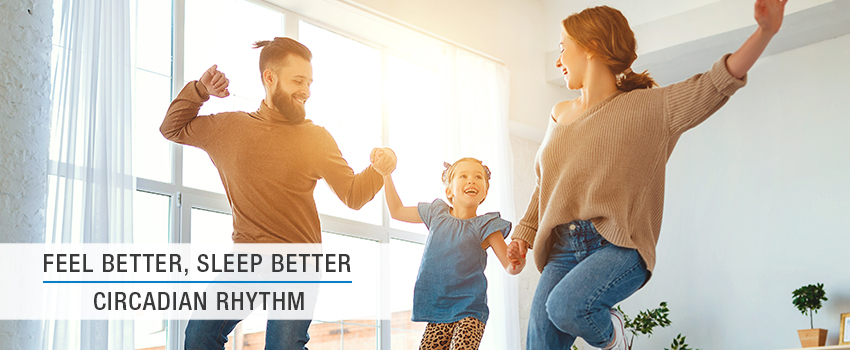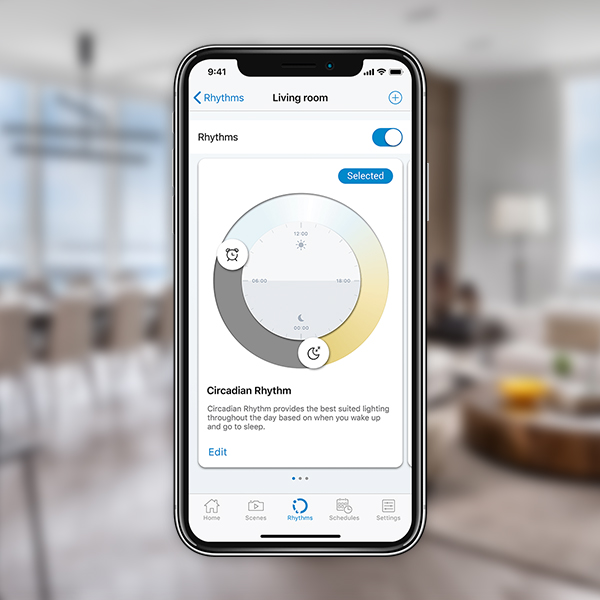
With Liteline’s latest launch of OnCloud smart home lighting, they have taken into consideration the affects of lighting on the human mind and body. With the integration of circadian rhythm in the OnCloud – WiZ ecosystem, users can now use lighting to benefit their lifestyle and sleep cycle to feel and sleep better.
What is Circadian Rhythm?
Since the beginning of time, light has played an important role for the human body. Sunlight is what helps to separate the day from night and provides an indication of time allowing us to know when it is time to wakeup or go to sleep. This is also known as our internal clock or circadian rhythm.
With evolution, came the invention of electricity and artificial lighting, which over time has started to affect mental health, mood, and sleep patterns as people alter their circadian rhythm working a nightshift, or staying on their phone late at night. Circadian rhythm in lighting, allows one to better replicate the sun’s natural progress throughout the day to improve mental health and sleep patterns.
How Does Circadian Rhythm Work?

A soft warm glow of light, like a sunrise in the morning or your lights gently turning on at 27 K, tells the body it is time to wake up and start the day. Melatonin, “a hormone released by the pineal gland that signals the suprachiasmatic nucleus that it’s time to go to sleep,”(2) is suppressed with the increase of light exposure making one feel awake. Therefore, it is easier to wake up naturally with the sun than it is from an alarm clock, or why it is hard to fall back asleep when the sun is creeping through your curtains.
As the day progresses, the sun becomes brighter, emitting stronger blue wavelengths, which makes you more alter and energized to go about your daily tasks.(1) As the sun sets, the color of light begins to change again to a warmer glow. This reduces the blue wavelengths, allowing the body to wind down and start producing melatonin in preparation for bedtime.
Liteline OnCloud and Circadian Rhythm
 Liteline OnCloud fixtures pair to your home Wi-Fi through the WiZ app for ultimate control. Within the app, there is a ‘rhythms’ option to set your lights to circadian rhythm. For each room you can set your wakeup and bedtime so your lights will have a natural progress during your day. Meaning, if you work a nightshift at home, your lights will progress throughout the hours you are awake to replicate the sun’s progress providing you with a warm glow in the morning to wake you up, a brighter blue during the day to provide energy, and them dimming down to a warm white in the evening to assist in melatonin production, making you sleep better, and feel better.
Liteline OnCloud fixtures pair to your home Wi-Fi through the WiZ app for ultimate control. Within the app, there is a ‘rhythms’ option to set your lights to circadian rhythm. For each room you can set your wakeup and bedtime so your lights will have a natural progress during your day. Meaning, if you work a nightshift at home, your lights will progress throughout the hours you are awake to replicate the sun’s progress providing you with a warm glow in the morning to wake you up, a brighter blue during the day to provide energy, and them dimming down to a warm white in the evening to assist in melatonin production, making you sleep better, and feel better.
FOOTNOTES
1. Harvard Health Publishing. (2020, July 7). Blue light has a dark side. Harvard Health.
https://www.health.harvard.edu/staying-healthy/blue-light-has-a-dark-side
2. Steber, C. (2019, December 17). Waking Up To Sunlight Does This To Your Brain. Bustle. https://www.bustle.com/p/waking-up-to-sunlight-does-this-to-your-brain-19448915#:%7E:text=%22Sunlight%20in%20the%20morning%20affects,to%20wake%20up%2C%22%20Dr.&text=%22When%20you%20wake%20up%20due,ll%20naturally%20feel%20sleepy%20again

